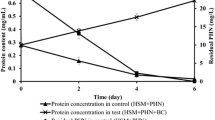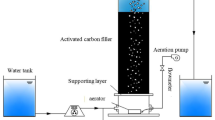Abstract
Bioremediation of a petroleum contaminated seawater from Persian Gulf was investigated and efficiency of natural attenuation by native halotolerant bacterial consortium, biostimulation by addition of macro nutrients (nitrogen and phosphorus) and surfactant and bioaugmentation by application of halotolerant hydrocarbon degrading strains were evaluated. Biodegradation rates in defined conditions were studied for 30 days. Four pure isolates including Bacillus sp. PG-1, Pseudomonas aeruginosa PG-2, Paenibacillus lautus PG-3, and Pseudomonas putida PG-4 were used to preparation of bacterial consortium. Results indicated that the bioaugmentation yielded the best TPH removal efficiency of 56.24%, followed by biostimulation with surfactant addition (removal of 31.52%). The most bacterial density was also observed for bioaugmentation bioreactor. Toxicity of reaction medium was evaluated by oxygen consumption rate inhibition, dehydrogenase activity inhibition and growth rate inhibition methods in which, the least toxicity rates of 27%, 25% and 31% were observed for bioaugmentation based bioreactor, respectively. Simultaneous bioaugmentation and biostimulation can efficiently reduce the crude oil content in the surface of seawater using halotolerant strains.






Similar content being viewed by others
References
Wrigley E (2013) Energy and the English industrial revolution. Philos Trans R Soc A Math Phys Eng Sci 371(1986):20110568
Oliveira ER, Silveira B, Alves FL (2014) Support mechanisms for oil spill accident response in costal lagoon areas (Ria de Aveiro, Portugal). J Sea Res 93:112–117
Karlapudi AP, Venkateswarulu T, Tammineedi J, Kanumuri L, Ravuru BK, Ramu Dirisala V, Kodali VP (2018) Role of biosurfactants in bioremediation of oil pollution—a review. Petroleum 4(3):241–249
Atlas RM, Hazen TC (2011) Oil biodegradation and bioremediation: a tale of the two worst spills in US history. ACS Publications. Environ Sci Technol 45:6709–6715
Villela HD, Peixoto RS, Soriano AU, Carmo FL (2019) Microbial bioremediation of oil contaminated seawater: a survey of patent deposits and the characterization of the top genera applied. Sci Total Environ 666:743–758
Zou C, Wang M, Xing Y, Lan G, Ge T, Yan X, Gu T (2014) Characterization and optimization of biosurfactants produced by Acinetobacter baylyi ZJ2 isolated from crude oil-contaminated soil sample toward microbial enhanced oil recovery applications. Biochem Eng J 90:49–58
Cho E, Park M, Hur M, Kang G, Kim YH, Kim S (2019) Molecular-level investigation of soils contaminated by oil spilled during the Gulf War. J Hazard Mater 373:271–277
Hughes TP, Anderson KD, Connolly SR, Heron SF, Kerry JT, Lough JM, Baird AH, Baum JK, Berumen ML, Bridge TC (2018) Spatial and temporal patterns of mass bleaching of corals in the Anthropocene. Science 359(6371):80–83
Cury JC, Jurelevicius DA, Villela HD, Jesus HE, Peixoto RS, Schaefer CE, Bícego MC, Seldin L, Rosado AS (2015) Microbial diversity and hydrocarbon depletion in low and high diesel-polluted soil samples from Keller Peninsula, South Shetland Islands. Antarct Sci 27(3):263–273
DeLeo DM, Ruiz-Ramos DV, Baums IB, Cordes EE (2016) Response of deep-water corals to oil and chemical dispersant exposure. Deep-Sea Res II Top Stud Oceanogr 129:137–147
Säwström C, Hyndes GA, Eyre BD, Huggett MJ, Fraser MW, Lavery PS, Thomson PG, Tarquinio F, Steinberg PD, Laverock B (2016) Coastal connectivity and spatial subsidy from a microbial perspective. Ecol Evol 6(18):6662–6671
Kalantary RR, Badkoubi A, Mohseni-Bandpi A, Esrafili A, Jorfi S, Dehghanifard E, Baneshi MM (2013) Modification of PAHs biodegradation with humic compounds. Soil Sediment Contam 22(2):185–198
Kalantary RR, Mohseni-Bandpi A, Esrafili A, Nasseri S, Ashmagh FR, Jorfi S, Ja’fari M (2014) Effectiveness of biostimulation through nutrient content on the bioremediation of phenanthrene contaminated soil. J Environ Health Sci Eng 12(1):143
Ahmadi M, Jorfi S, Kujlu R, Ghafari S, Soltani RDC, Haghighifard NJ (2017) A novel salt-tolerant bacterial consortium for biodegradation of saline and recalcitrant petrochemical wastewater. J Environ Manag 191:198–208
Ghafari S, Baboli Z, Neisi A, Mirzaee S, Darvishi Cheshmeh Soltani R, Saeedi R, Abtahi M, Jorfi S (2019) Surfactant-enhanced bioremediation of n-hexadecane-contaminated soil using halo-tolerant bacteria paenibacillus glucanolyticus sp. Strain T7-AHV isolated from marine environment. Chem Biochem Eng Q 33(1):111–123
Zahed M, Aziz H, Isa M, Mohajeri L (2010) Enhancement biodegradation of n-alkanes from crude oil contaminated seawater. Int J Environ Res 4(4):655–664
Xu X, Liu W, Tian S, Wang W, Qi Q, Jiang P, Gao X, Li F, Li H, Yu H (2018) Petroleum hydrocarbon-degrading bacteria for the remediation of oil pollution under aerobic conditions: a perspective analysis. Front Microbiol 9:2885
Jorfi S, Rezaee A, Mobeh-Ali G-A, Jaafarzadeh NA (2013) Application of biosurfactants produced by Pseudomonas aeruginosa SP4 for bioremediation of soils contaminated by pyrene. Soil Sediment Contam 22(8):890–911
Mukherjee AK, Bordoloi NK (2011) Bioremediation and reclamation of soil contaminated with petroleum oil hydrocarbons by exogenously seeded bacterial consortium: a pilot-scale study. Environ Sci Pollut Res Int 18(3):471–478
Shetaia YMH, El Khalik WAA, Mohamed TM, Farahat LA, El Mekawy A (2016) Potential biodegradation of crude petroleum oil by newly isolated halotolerant microbial strains from polluted Red Sea area. Mar Pollut Bull 111(1):435–442
Bidja Abena MT, Sodbaatar N, Li T, Damdinsuren N, Choidash B, Zhong W (2019) Crude oil biodegradation by newly isolated bacterial strains and their consortium under soil microcosm experiment. Appl Biochem Biotechnol 189(4):1223–1244
Tayybi T, Jorfi S, Ghaffari S, Kujlu R (2016) Bioremediation of n-hexadecane contaminated soils using pseudomonas aeruginosa bacteria isolated from coastal areas. J Mazandaran Univ Med Sci 26(140):127–136
Jorfi S, Samaei MR, Darvishi Cheshmeh Soltani R, Talaie Khozani A, Ahmadi M, Barzegar G, Reshadatian N, Mehrabi N (2017) Enhancement of the bioremediation of pyrene-contaminated soils using a hematite nanoparticle-based modified fenton oxidation in a sequenced approach. Soil Sediment Contam 26(2):141–156
Freschi CR, Oliveira CJBd (2005) Comparison of DNA-extraction methods and selective enrichment broths on the detection of Salmonella Typhimurium in swine feces by polymerase chain reaction (PCR). Braz J Microbiol 36 (4):363-367
Weisburg WG, Barns SM, Pelletier DA, Lane DJ (1991) 16S ribosomal DNA amplification for phylogenetic study. J Bacteriol 173(2):697–703
Yoon S-H, Ha S-M, Kwon S, Lim J, Kim Y, Seo H, Chun J (2017) Introducing EzBioCloud: a taxonomically united database of 16S rRNA gene sequences and whole-genome assemblies. Int J Syst Evol Microbiol 67(5):1613–1617
Tamura K, Peterson D, Peterson N, Stecher G, Nei M, Kumar S (2011) MEGA5: molecular evolutionary genetics analysis using maximum likelihood, evolutionary distance, and maximum parsimony methods. Mol Biol Evol 28(10):2731–2739
ISO (2007) Water quality–test for inhibition of oxygen consumption by activated sludge for carbonaceous and ammonium oxidation. International Organization for Standardization, Geneva, Switzerland
Le Bail J, Laroche T, Marre-Fournier F, Habrioux G (1998) Aromatase and 17β-hydroxysteroid dehydrogenase inhibition by flavonoids. Cancer Lett 133(1):101–106
ISO (1999) Water quality–test for inhibition of oxygen consumption by activated sludge for carbonaceous and ammonium oxidation. International Organization for Standardization: 15522, Geneva
Wef AA (2005) Standard methods for the examination of waterand wastewater, 21st edn. American Public Health Association, AmericanWater Works Association, Water Environmental Federation, Washington, DC
Gao H, Zhang J, Lai H, Xue Q (2017) Degradation of asphaltenes by two Pseudomonas aeruginosa strains and their effects on physicochemical properties of crude oil. Int Biodeterior Biodegradation 122:12–22
Zhang X, Xu D, Zhu C, Lundaa T, Scherr KE (2012) Isolation and identification of biosurfactant producing and crude oil degrading Pseudomonas aeruginosa strains. Chem Eng J 209:138–146
Cai B, Ma J, Yan G, Dai X, Li M, Guo S (2016) Comparison of phytoremediation, bioaugmentation and natural attenuation for remediating saline soil contaminated by heavy crude oil. Biochem Eng J 112:170–177
Horel A, Mortazavi B, Sobecky PA (2014) Biostimulation of weathered MC252 crude oil in northern Gulf of Mexico sandy sediments. Int Biodeterior Biodegradation 93:1–9
Chekroud Z, Gouda M, Houhamdi M (2018) Bioremediation of crude oil contaminated sea water in lab microcosms. In: Kallel A, Ksibi M, Ben Dhia H, Khélifi N (eds) Recent advances in environmental science from the Euro-mediterranean and surrounding regions, EMCEI 2017. Advances in Science, Technology & Innovation (IEREK Interdisciplinary Series for Sustainable Development). Springer, Cham, pp 351–353
Ramírez IM, Tsaousi K, Rudden M, Marchant R, Alameda EJ, Román MG, Banat IM (2015) Rhamnolipid and surfactin production from olive oil mill waste as sole carbon source. Bioresour Technol 198:231–236
Ghosh J, Tick GR, Akyol NH, Zhang Y (2019) A pore-scale investigation of heavy crude oil trapping and removal during surfactant-enhanced remediation. J Contam Hydrol 223:103471
Uddin M, Chen J, Qiao X, Tian R, Arafat Y, Yang X (2019) Bacterial community variations in paddy soils induced by application of veterinary antibiotics in plant-soil systems. Ecotox Environ Safe 167:44–53
Hostins B, Lara G, Decamp O, Cesar DE, Wasielesky W Jr (2017) Efficacy and variations in bacterial density in the gut of Litopenaeus vannamei reared in a BFT system and in clear water supplemented with a commercial probiotic mixture. Aquaculture 480:58–64
Nikolopoulou M, Pasadakis N, Kalogerakis N (2013) Evaluation of autochthonous bioaugmentation and biostimulation during microcosm-simulated oil spills. Mar Pollut Bull 72(1):165–173
Liang J, X-a N, Sun J, Song J, Lu J, Cai H, Hong Y (2018) Toxicity evaluation of textile dyeing effluent and its possible relationship with chemical oxygen demand. Ecotoxicol Environ Saf 166:56–62
Ra J-S, Jeong T-Y, Lee S-H, Kim SD (2016) Application of toxicity identification evaluation procedure to toxic industrial effluent in South Korea. Chemosphere 143:71–77
Poremba K, Gunkel W, Lang S, Wagner F (1991) Toxicity testing of synthetic and biogenic surfactants on marine microorganisms. Environ Toxicol Water Qual 6(2):157–163
Atagana HI, Haynes RJ, Wallis FM (2003) The use of surfactants as possible enhancers in bioremediation of creosote contaminated soil. Water Air Soil Pollut 142(1):137–149
Miller RM (2015) Surfactant-enhanced bioavailability of slightly soluble organic compounds. In: Skipper HD, Turco RF (eds) Bioremediation: science and applications, 1995, SSSA special publications. USA Soil Science Society of America Inc, Madison
Zenati B, Chebbi A, Badis A, Eddouaouda K, Boutoumi H, El Hattab M, Hentati D, Chelbi M, Sayadi S, Chamkha M (2018) A non-toxic microbial surfactant from Marinobacter hydrocarbonoclasticus SdK644 for crude oil solubilization enhancement. Ecotox Environ safe 154:100–107
Pi Y, Xu N, Bao M, Li Y, Lv D, Sun P (2015) Bioremediation of the oil spill polluted marine intertidal zone and its toxicity effect on microalgae. Environ Sci Process Impacts 17(4):877–885
Carriere PPE, Mesania FA (1995) Enhanced biodegradation of creosote-contaminated soil. Waste Manag 15(8):579–583
Acknowledgements
The funding of this research was provided by Ahvaz Jundishapur University of Medical Sciences (Grant no ETRC 9417).
Author information
Authors and Affiliations
Corresponding author
Additional information
Publisher’s Note
Springer Nature remains neutral with regard to jurisdictional claims in published maps and institutional affiliations.
Rights and permissions
About this article
Cite this article
Dehvari, M., Ghafari, S., Haghighifard, N.J. et al. Petroleum Contaminated Seawater Detoxification in Microcosm by Halotolerant Consortium Isolated from Persian Gulf. Curr Microbiol 78, 95–106 (2021). https://doi.org/10.1007/s00284-020-02267-x
Received:
Accepted:
Published:
Issue Date:
DOI: https://doi.org/10.1007/s00284-020-02267-x




